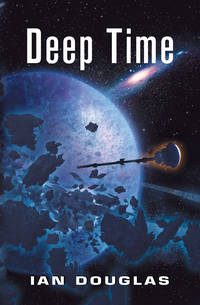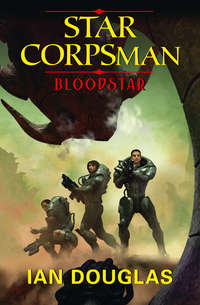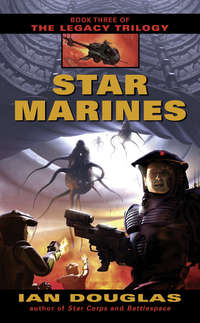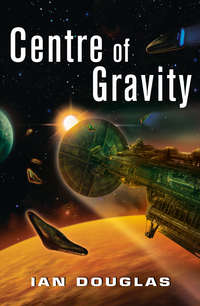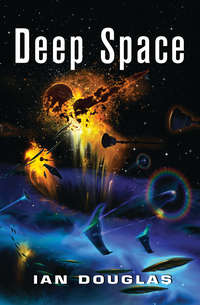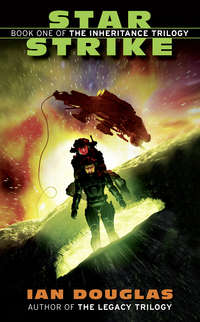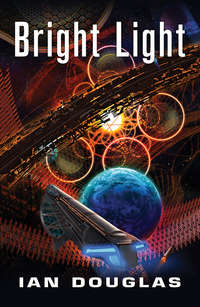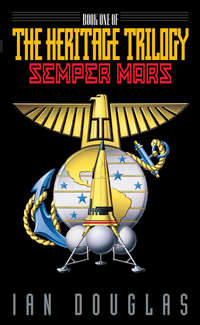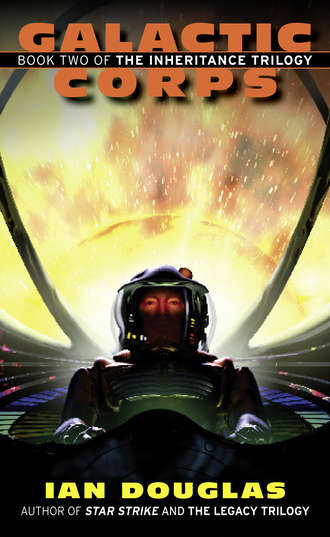
Полная версия
Galactic Corps

GALACTIC CORPS
BOOK TWO OF THE INHERITANCE TRILOGY
IAN DOUGLAS

As always, for Brea. My light. My life. My muse.
Table of Contents
Title Page
Dedication
Timeline of the Inheritance Universe
Countdown …
Prologue
Chapter 1
Chapter 2
Chapter 3
Chapter 4
Chapter 5
Chapter 6
Chapter 7
Chapter 8
Chapter 9
Chapter 10
Chapter 11
Chapter 12
Chapter 13
Chapter 14
Chapter 15
Chapter 16
Chapter 17
Chapter 18
Chapter 19
Chapter 20
Chapter 21
Chapter 22
Chapter 23
Chapter 24
Chapter 25
Epilogue
Also by Ian Douglas
Copyright
About the Publisher
Timeline of the Inheritance Universe
Years before present
50,000,000–30,000,000: Galaxy dominated by the One Mind, sentient organic superconductors with hive mentality. They create the network of stargates across the Galaxy, and build the Encyclopedia Galactica Node at the Galactic Core.
30,000,000–10,000,000: Dominance of Children of the Night, nocturnal psychovores. They replace the One Mind, which may have transcended material instrumentality.
10,000,000 TO PRESENT: Dominance of the Xul, also known as the Hunters of the Dawn. Originally polyspecific pantovores, they eventually exist solely as downloaded mentalities within artificial cybernetic complexes.
Circa 500,000 B.C.E.: Advanced polyspecific machine intelligence, later called variously the Ancients or the Builders, extends a high-technology empire across a volume of space several thousand light years in extent. Extensive planoforming of Chiron, at Alpha Centauri A, of Mars in the nearby Sol System, and of numerous other worlds. QCC networks provide instantaneous communications across the entire empire. Ultimately, the Builder civilization is destroyed by the Xul. Asteroid impacts strip away the newly generated Martian atmosphere and seas, but Earth, with no technological presence, is ignored. A Xul huntership is badly damaged in the battle over Mars; it later crashes into the Europan world-sea and is frozen beneath the ice. Survivors of the Martian holocaust migrate to Earth and upload themselves into gene-tailored primates that later will be known as Homo sapiens.
10,000 B.C.E.–7500 B.C.E.: Earth and Earth’s Moon colonized by the Ahannu, or An, who are later remembered as the gods of ancient Sumeria. Around 7500 B.C.E., asteroid strikes by the Xul destroy An colonies across their empire. Earth is devastated by asteroid strikes. One colony, at Lalande 21185, survives.
Circa 6000 B.C.E.: Amphibious N’mah visit Earth and help human survivors of Xul attack develop civilization. They are later remembered as the Nommo of the Dogon tribe of Africa, and as civilizing/agricultural gods by other cultures in the Mideast and the Americas.
Circa 6000–5000 B.C.E.: N’mah starfaring culture destroyed by the Xul. Survivors exist in low-technology communities within the Sirius Stargate and, possibly, elsewhere.
1200 B.C.E. [Speculative]: The Xul revisit Earth and discover an advanced Bronze Age culture. Asteroid impacts cause devastating floods worldwide, and may be the root of the Atlantis myth.
700 C.E.: The deep abyssal intelligence later named the Eulers fight the Xul to a standstill by detonating their own stars. The astronomical conflagration of artificial novae is seen in the skies of Earth, in the constellation Aquila, some 1,200 years later.
The Heritage Trilogy
2039–2042: Semper Mars
2040: 1st UN War. March by “Sands of Mars Garroway.” Battle of Cydonia. Discovery of the Cydonian Cave of Wonders.
2040–2042: Luna Marine
2042: Battle of Tsiolkovsky. Discovery of An base on the Moon.
2067: Europa Strike
2067: Sino-American War. Discovery of the Singer under the Europan ice.
The Legacy Trilogy
2138–2148: Star Corps
2148: Battle of Ishtar. Treaty with An of Lalande 21185. Earth survey vessel The Wings of Isis destroyed while approaching the Sirius Stargate.
2148–2170: Battlespace
2170: Battle of Sirius Gate. Contact with the N’mah, an amphibious species living inside the gate structure. Data collected electronically fills in some information about the Xul, and leads to a Xul node in Cluster Space, 30,000 light years from Sol. A Marine assault force uses the gate to enter Cluster Space and destroy this gate.
2314–2333: Star Marines
2314: Armageddonfall
2323: Battle of Night’s Edge. Destruction of Xul fleet and world in Night’s Edge Space.
The Inheritance Trilogy
2877: Star Strike
2877 [1102 M.E.]: 1MIEF departs for Puller 659. Battle of Puller 659 against Pan-Europe ans. Contact with Eulers in Cygni Space. Battle of Cygni Space. Destruction of star in Starwall Space, eliminating local Xul node.
2886: Galactic Corps
2886 [1111 M.E.]: Raid on Cluster Space by 1MIEF. Discovery of stargate path to major Xul node at Galactic Core.
2887 [1112 M.E.]: Operation Heartfire. Assault on the Galactic Core.
Countdown …
They had about ten and a half minutes yet, give or take a bit, before the expanding blast wave of the nova reached them. Plenty of time if nothing unexpected happened.
“Skipper! I’ve got a bender coming through dead ahead!”
She checked the ID. The call was from second lieutenant Trace Wayne, only thirty kilometers off Lee’s port wing. A bender was something warping space, possibly one of the Euless triggerships … but there was a chance it was something else.
It was. She saw the brilliant flash of twisted starlight, saw the Xul Type IV materialize out of empty space fifty kilometers ahead. Like humans, the Xul used the Galaxy-spanning network of stargates, but their ships also possessed FTL capability which sharply warped local space.
And the alien warship had dropped into the normal space time matrix directly between most of Lee’s squadron and the stargate.
They were going to have to fight to get through.
Prologue
They were not omnipotent.
Throughout their multi-million-year period of galactic dominance, they’d been known by many names. The Destroyers. The Hunters of the Dawn. The Enemy. The Xul. They called themselves by a thought symbol that might translate as We Who Are.
Perhaps ten million years ago, give or take some few hundreds of thousands of years, We Who Are had possessed organic bodies; as such, they’d been a species, like all heirs of flesh, shaped and constrained by the impersonal forces of evolution. In common with all products of the evolutionary process, they’d possessed a marked will to survive.
What most clearly distinguished We Who Are from most other species was simply the extremes to which that will carried them.
Early in their history, they’d survived—barely—a traumatic encounter with another species upon their home planet. That encounter left them shaken, brutalized, and monomaniacally mistrustful of the motives of anything Other.
It left the other species extinct.
That ancient struggle for dominance, ultimately for survival, imprinted itself upon the psyche of We Who Are. When, in due time, they began moving out into the Galaxy, they carried that imprint with them. No other species posing a threat, however remote, to We Who Are could be permitted to survive.
Over the course of some millions of years, We Who Are extended and expanded the range of their lonely suzerainty over the Galaxy. Eventually, however, they encountered the far-flung bastions of another starfaring species, nocturnal psychovores who styled themselves as the Children of the Night. Like We Who Are, the Children possessed as a racial trait the need to exterminate all competition. Unlike We Who Are at that time, perhaps eight million years ago, the Children were already ancient, their line extending back into a murkily remote past when they, in their season, had wrested dominance of the Galaxy from a still more remote species, a self-aware congeries of organic superconductors that called themselves the One Mind.
Young, fired with righteous ambition and an instinctive determination to crush all competition in order to be alone, and therefore safe, within their Galactic fastnesses, We Who Are eventually triumphed after a savage no-quarters war that scoured a hundred thousand worlds of life. The Children of the Night passed into the ultimate Night of extinction, as had the One Mind before them.
And with that victory, the We Who Are became the new xenophobically senticidal caretakers of the Galaxy.
More millions of years passed. Eventually, like the majority of technically oriented species before them, We Who Are chose to discard their organic bodies, uploading their consciousnesses into nearly immortal cybernetic shells. They carried with them, however, the racial traits of mind and awareness that had distinguished them as organic beings—including the blatantly Darwinian imperative to eliminate all possible competitors, all possible threats to their existence.
In fact, this radical form of natural selection had dominated the galactic scene ever since sentient life had first emerged, some eight billion years before. In any given epoch, it took only a single intelligent species with technic aptitude and a lack of empathy for anything Other to emerge from the cauldron of its birthworld and insure its survival by eliminating all possible rivals. Galactic civilizations rarely overlapped perfectly in terms of their scientific and technical levels; with each encounter, one species tended to be older than the other, usually by many thousands or tens of thousands of years, and hence far more technically advanced.
As new civilizations emerged and achieved technical capabilities permitting space flight and long-distance communication, most wondered why the skies of their worlds, which should have been humming with the signs of advanced civilizations, seemed so silent, so empty. Each time new races, new civilizations took their first tentative steps out beyond the worlds of their genesis, We Who Are, sooner or later, detected their efforts from their scattered bastions, descended upon their worlds, and relentlessly exterminated them. Hence, the silent sky.
But like the Children of the Night, the One Mind, and so many others who’d come before, We Who Are were not omnipotent. The vast, sprawling spiral of the Galaxy, possessing some three hundred billion stars, is far too large, with far too many worlds, for any one race to monitor every possible lifeworld, every emerging sentient species.
And there were so many of these. …
In the outlying regions of the Galaxy’s Perseus Arm, within the dense polar jungles of the warm, inner world of a class-G5 star, a race of brachiating mollusks—morphologically, at least, they somewhat resembled certain members of that terrestrial phylum—swung from the interwoven branches of sessile thermovores not unlike Earthly trees. The species was young, as yet, but had developed an elaborate philosophy based on mating calls, territoriality, music, and mathematics. One day, they might have much to offer an evolving Galactic polylogue, but they hadn’t yet developed electronics or radio, much less the instantaneous magic of quantum-coupled communications. The huntership-communes of We Who Are had passed through this star system several times within the past ten thousand or so years, but not noticed the species’ thriving, arboreal cities.
Not yet.
Closer in toward the galactic core, within the teeming star clouds of the Sagittarius Arm, on the rugged, tide-strained volcanic moon of a superjovian gas giant, a race of armored paraholothurids built water’s-edge hive-cities of compacted excrement and composed palendromic epics celebrating their having been chosen as slaves of the sky-disk they saw as the eye of God. Natural radio emitters, they broadcast the glory of the one true religion to the stars. We Who Are had detected those signals and searched for their origin; so far, they’d not found the holothurids’ world, for they tended not to think of planetary bodies outside of the star’s liquid-water habitable zone as a possible abode of life.
That particular blind spot had given them trouble more than once in the past, and likely would again.
Closer in still toward the galactic hub, near the merging of the Norma and Scutum-Crux Arms, a fiercely radiating type A star blasted its unusual coterie of rocky worlds with intense radiation. Bathed in abundant radiant energy, Life had emerged on the innermost world and, borne by the local stellar winds, had seeded the other, outer planets of the system as well. Sentience had arisen here a few million years before, rising among several of the numerous, fast-evolving taxas of selenium-germanium chelated crystalline chemovores that constituted the local biosphere. Here, again, the manipulation of naturally occurring radio waves became the basis for communication, and, again, those manipulations had been detected in the depths of space, light-years distant.
The pace of crystalline life, however, tends to be slow, too slow for We Who Are to distinguish that life from the inorganic chemistry of accreted minerals. Those received artificial signals had caused the local We Who Are node some considerable concern, but it was clear that the problem soon would take care of itself. Type A giants are short-lived stars, their lifetimes on the main sequence lasting less than half a billion years. The local star already was showing signs of instability, and soon the abundant radiation that made life and sentience possible here would become that life’s executioner.
Twenty-three thousand light years from the Galaxy’s center, within the smear of stars and nebulae known as the Orion Arm, a world called Chiron by its most recent inhabitant, represented two distinct threads of civilization within the Galactic scene. Bathed in the yellow and orange hues of a double star, the world’s continents were battered and cratered by an intense celestial bombardment of half a million years before, and everywhere stood the somber and silent ruins of a golden civilization swept away by the firestorm. They were known by those who’d come later variously as the Ancients and, so numerous were the crumbling shells of their hell-blasted world-cities, as the Builders.
The Builder civilization had been a brilliant concord of machine intelligences arisen and evolved from various organic precursors; the asteroids that had destroyed Chiron had been flung into the planet by We Who Are, whose hunterships had sought out the Builders’ colony worlds scattered widely across perhaps a third of the Galaxy and in like manner, relentlessly and methodically exterminated each one.
Chiron was also known to its more recent colonists as Alpha Centauri A-II. Just four and a third light years away lay the G2 star called Sol, and the homeworld of an ambitious, carbon-based, oxygen-metabolizing species of sexual mammals that called itself Humankind. Within the past thousand years, an eye’s blink against the span marking the rise and extinction of myriad expressions of galactic life and sentience, humans and their artificially sentient machines had left the world of their birth to venture to the worlds of nearby stars, beginning with Chiron, and going on to assimilate numerous star systems scattered throughout an oblong realm measuring perhaps eight light centuries across at its greatest extent, four at its smallest. They’d encountered other intelligent species—the primitive An, the advanced but retiring N’mah, and the benthic species of brilliant mathematicians known to them as the Eulers—all three the shattered remnants of past encounters with We Who Are.
And, more than once within the past handful of centuries, Humankind, too, had attracted the xenocidal attention of We Who Are, and the destructiveness of those encounters was rapidly escalating. Most recently, a human battlefleet had used an ancient system of stargates to reach an important node of We Who Are near the Galactic hub, and there used Euler technology to detonate the star.
The resultant nova had finally caught the full attention of the Galaxy’s overlords.
And they moved now with blatantly uncharacteristic haste to obey their racial hard-wiring and eliminate once and for all this new and potentially serious threat to their survival.
The final clash, the final Armageddon would come soon, and, when it did, it would do so on a scale unknown since the extinction of the Builders.
1
1506.1111
First Platoon, Bravo Company
Carson Gate/Cluster Space
0540 hrs, GMT
Gunnery Sergeant Aiden Garroway wiggled a bit deeper into the bottle’s embrace as the armorer swung the dome canopy down over his head and sealed it in place. “Link check,” he heard, the Navy chief’s words forming in his mind.
The canopy was opaque, a nanosurfaced ceramic-iridium laminate impervious to almost anything up to a direct hit by a 100-gigawatt laser, but the bottle’s electronics fed the external view directly into Garroway’s brain, channeling the data through his cerebral implants. The armorer’s face leered down at him, distorted by the feed’s fisheye effect, and by the reflections from the fishbowl helmet of the man’s vacwear utilities.
“Link is on-line,” Garroway replied. “You’re going to have to fix that, though, Chief. God, you’re ugly.”
The man laughed. “Not as ugly as the Xulies. Good luck, Marine.”
“Ooh-rah.” With a thoughtclick, Garroway switched the data link to an external view, fed from the Ishtar’s outer hull.
The view here, high above the stargate, was stunning, spectacular. …
Carson was a nondescript double star near the fringe of Commonwealth space, a planetless pair of cool M-class dwarfs circling one another in a tight embrace. Two light hours out, so distant that the two suns themselves were merely bright ruby points of light against the background scattering of stars, the local stargate drifted in slow orbit, an immense, slender-rimmed hoop twenty kilometers across, gleaming silver and red in the somber light.
The Marine transport Ishtar was drifting slowly toward the gate belly-first, some fifteen kilometers above the structure’s center. Her ventral hatches were open, her forward dropdeck exposed to hard vacuum—hence the need for the armorer’s helmet and sealed utilities.
He switched the feed back to his pod’s external optics. Around him, caught in the glare of overhead lights, were the launch racks holding other bottles, and Navy and Marine personnel—armorers, deckhands, and technicians—were moving among them, prepping each for drop.
“Be sure to bring back some good suit vids, okay, Gunny?” the armorer told him. “I hear it’s real pretty over there.”
“I’ll see what I can do, Chief. But I imagine we’re going to be too busy to get anything artistic.”
“Shit, I didn’t say artistic. I just hear the view’s nice, is all. What I really want to see is some after-op combat footage of a bunch of dead Xulies!”
“You and me both, Chief.”
“Bravo Company,” another voice said, cutting in. The dry, staccato tones were those of the company commanding officer, Captain John “Blackjack” Black, though the actual speaker would be Smedley, the company AI. “Squad and section leaders, check your Marines and report status.”
Garroway was the gunnery sergeant assigned to the company HQ, and, as such, was the senior NCO in charge of the seven other enlisted Marines in the unit, under Captain Black himself. He ran through the electronic links with the other HQ personnel—two riflemen, two comm officers, two Navy hospital corpsmen, and a tech specialist/observer. All feeds showed green and ready, systems charged and go, weapons safed and ready.
“Green Tower,” he said over the company net, using the HQ section’s code name to link through to Smedley. “This is Tower Two. All Tower platforms report ready for drop.”
“Copy, Two,” Smedley replied.
Garroway chuckled. The AI was named after Major General Smedley Butler, one of the Corps’ heroes from the ancient, pre-spaceflight era of almost a thousand years ago. According to the histories, though, the original Smedley had been quite a character, often in trouble with his superiors because of his rough manner. Somehow, Garroway doubted that the guy had been quite as laconic as his artificial namesake.
There were historical simulations of the original Butler on file back on Mars, and in the library on board the Hermes. He decided he would link in some time, just to see how the two compared.
“First Platoon, ready to launch,” 2nd Lieutenant Cooper, the platoon’s commanding officer, announced over the Net.
“Second Platoon, ready to go.” That was 2nd Lieutenant Hamblet.
“Third Platoon, ready,” 2nd Lieutenant Costigan added.
“PryFly, Bravo Company,” the captain’s voice said. Garroway thought he heard some stress there. If so, it was the old man himself speaking, and not his electronic proxy. “We are ready for launch.”
“Very well,” another voice said, this one from Ishtar’s primary flight control center, or PryFly. “Bravo Company release in five … four … three … two … one … release!”




